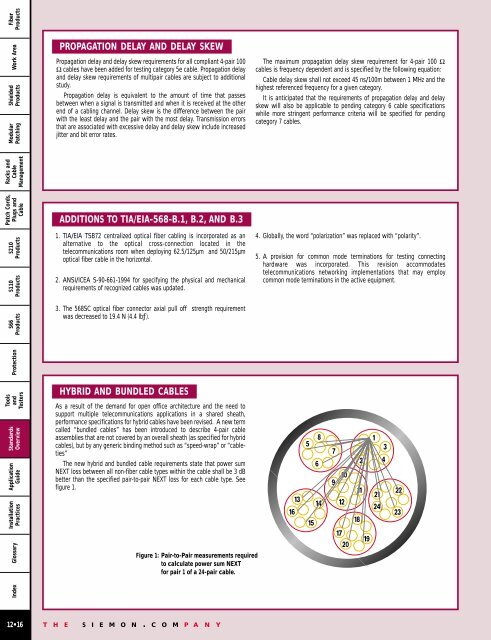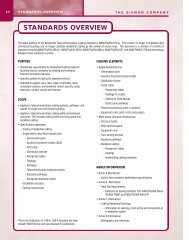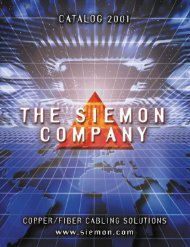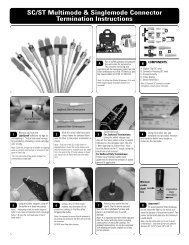fiber products
fiber products
fiber products
Create successful ePaper yourself
Turn your PDF publications into a flip-book with our unique Google optimized e-Paper software.
Work Area<br />
Shielded<br />
Products<br />
Modular<br />
Patching<br />
Index<br />
Patch Cords,<br />
Plugs and<br />
Cable<br />
Installation<br />
Practices<br />
Protection<br />
Racks and<br />
Cable<br />
Management<br />
Fiber<br />
Products<br />
PROPAGATION DELAY AND DELAY SKEW<br />
Propagation delay and delay skew requirements for all compliant 4-pair 100<br />
Ω cables have been added for testing category 5e cable. Propagation delay<br />
and delay skew requirements of multipair cables are subject to additional<br />
study.<br />
Propagation delay is equivalent to the amount of time that passes<br />
between when a signal is transmitted and when it is received at the other<br />
end of a cabling channel. Delay skew is the difference between the pair<br />
with the least delay and the pair with the most delay. Transmission errors<br />
that are associated with excessive delay and delay skew include increased<br />
jitter and bit error rates.<br />
The maximum propagation delay skew requirement for 4-pair 100 Ω<br />
cables is frequency dependent and is specified by the following equation:<br />
Cable delay skew shall not exceed 45 ns/100m between 1 MHz and the<br />
highest referenced frequency for a given category.<br />
It is anticipated that the requirements of propagation delay and delay<br />
skew will also be applicable to pending category 6 cable specifications<br />
while more stringent performance criteria will be specified for pending<br />
category 7 cables.<br />
S210<br />
Products<br />
S110<br />
Products<br />
ADDITIONS TO TIA/EIA-568-B.1, B.2, AND B.3<br />
1. TIA/EIA TSB72 centralized optical <strong>fiber</strong> cabling is incorporated as an<br />
alternative to the optical cross-connection located in the<br />
telecommunications room when deploying 62.5/125µm and 50/215µm<br />
optical <strong>fiber</strong> cable in the horizontal.<br />
2. ANSI/ICEA S-90-661-1994 for specifying the physical and mechanical<br />
requirements of recognized cables was updated.<br />
4. Globally, the word “polarization” was replaced with “polarity”.<br />
5. A provision for common mode terminations for testing connecting<br />
hardware was incorporated. This revision accommodates<br />
telecommunications networking implementations that may employ<br />
common mode terminations in the active equipment.<br />
S66<br />
Products<br />
3. The 568SC optical <strong>fiber</strong> connector axial pull off strength requirement<br />
was decreased to 19.4 N (4.4 lbƒ).<br />
Tools<br />
and<br />
Testers<br />
Standards<br />
Overview<br />
Application<br />
Guide<br />
HYBRID AND BUNDLED CABLES<br />
As a result of the demand for open office architecture and the need to<br />
support multiple telecommunications applications in a shared sheath,<br />
performance specifications for hybrid cables have been revised. A new term<br />
called “bundled cables” has been introduced to describe 4-pair cable<br />
assemblies that are not covered by an overall sheath (as specified for hybrid<br />
cables), but by any generic binding method such as “speed-wrap” or “cableties”<br />
The new hybrid and bundled cable requirements state that power sum<br />
NEXT loss between all non-<strong>fiber</strong> cable types within the cable shall be 3 dB<br />
better than the specified pair-to-pair NEXT loss for each cable type. See<br />
figure 1.<br />
Glossary<br />
Figure 1: Pair-to-Pair measurements required<br />
to calculate power sum NEXT<br />
for pair 1 of a 24-pair cable.<br />
12•16<br />
T H E S I E M O N . C O M P A N Y








